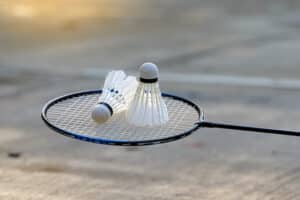How to Build a Badminton Court in Your Backyard?
Key Takeaways
- Choosing the Right Materials:
- Wooden courts are durable and provide a natural feel, but require regular maintenance.
- Synthetic courts are cost-effective and easier to maintain, but may not offer the same natural feel as wooden courts.
- Acrylic courts are weather-resistant and relatively easy to maintain, but can be more expensive.
- Dedicated badminton court mats provide a smooth and stable surface, but may not be as durable.
- Marking Out the Court Dimensions:
- The court dimensions should be 44 feet long by 17 feet wide for singles matches, and 44 feet long by 20 feet wide for doubles matches.
- The boundary lines, center line, short service lines, long service lines, center line extension, service court, service boxes, and net height and poles should all be marked according to official regulations.
- The Cost of Building a Badminton Court:
- The cost can range from $5,000 to $20,000, depending on factors such as location, size, materials, design elements, and additional features.
- Consider your budget and priorities when planning the construction of your court.
Have you ever dreamed of having your very own badminton court in your backyard? Imagine being able to play this exciting and fast-paced sport anytime you want, without having to travel to a local facility. Well, the good news is that building a badminton court in your backyard is not as difficult as you might think. In this article, we will guide you through the process of creating your own backyard badminton court, from choosing the right materials to properly marking out the court dimensions. Let’s get started!
Choosing the Right Materials
When it comes to the materials for your backyard badminton court, there are several options to consider. Each material has its own pros and cons, so it’s important to choose the one that best fits your needs and budget.
- Wooden Courts: Wooden courts are known for their durability and natural feel. They provide a solid surface for playing badminton and can withstand different weather conditions. However, they require regular maintenance and can be more expensive compared to other options.
- Synthetic Courts (PVC/PU): Synthetic courts, made from materials like PVC or PU, are a cost-effective option. They are slip-resistant and provide good shock absorption. They are also easier to maintain compared to wooden courts. However, they may not offer the same natural feel as wooden courts.
- Acrylic Courts: Acrylic courts are weather-resistant and can withstand different climates. They are also relatively easy to maintain. However, they can be more expensive compared to other materials.
- Dedicated Badminton Court Mats: Dedicated badminton court mats are designed specifically for badminton and provide a smooth and stable surface. They are easy to install and can be rolled up for storage. However, they may not be as durable as other materials.
Consider your budget, maintenance requirements, and desired playing experience when choosing the material for your backyard badminton court. Now that you have chosen the material, let’s move on to marking out the court dimensions.
Marking Out the Court Dimensions
Properly marking out the court dimensions is crucial to ensure a fair and enjoyable game of badminton. The Badminton World Federation (BWF) has set official measurements and regulations for court dimensions, which should be followed for both singles and doubles matches.
- Overall Court Dimensions: The court should be 44 feet long by 17 feet wide for singles matches, and 44 feet long by 20 feet wide for doubles matches.
- Boundary Lines: The boundary lines should be at least 0.1 meters wide and marked with a white line or tape.
- Center Line: Divide the court in half with a center line, also at least 0.1 meters wide.
- Short Service Lines: Mark the short service lines on both sides of the court, each 0.76 meters long.
- Long Service Lines: Draw the long service lines 0.76 meters from the back boundary lines, each 6.1 meters long.
- Center Line Extension: Mark the center line from the back boundary line to the long service line.
- Service Court: Mark the service court on both sides of the court, each 6.1 meters long and 1.98 meters wide, with lines 0.1 meters wide.
- Service Boxes: Mark the service boxes on both sides of the court, each 0.9 meters wide, with a white line or tape.
- Net Height and Poles: Set the net height at 1.55 meters and position the poles 1.55 meters apart. Fasten the net to the poles at the net height.
Make sure to use a measuring tape for accurate measurements and non-permanent markings that can be easily removed. Following these guidelines will help ensure a fair and professional playing environment.
The Cost of Building a Badminton Court
The cost of building a backyard badminton court can vary depending on several factors. The location of the court, the size of the court, the materials used, the design elements chosen, and any additional features like lighting and fencing can all influence the overall cost.
According to various sources, the cost of building a backyard badminton court can range from as little as $5,000 to as much as $20,000. It’s important to consider your budget and priorities when planning the construction of your court. Whether you opt for a more affordable option or invest in higher-quality materials and additional features, make sure to choose what suits your needs and financial situation.
Related Websites:
FAQs:
Q: What are the benefits of playing badminton?
Playing badminton offers numerous benefits, including improved cardiovascular health, increased agility and coordination, and the opportunity to socialize and make new friends.
Q: How do I assess my backyard for building a badminton court?
To assess your backyard, measure the available space and ensure it meets the required dimensions for a badminton court. Consider factors such as soil type, drainage, and potential obstacles that may need to be addressed.
Q: What are the standard dimensions and layout of a badminton court?
A standard badminton court has dimensions of 20 feet wide for singles play and 44 feet wide for doubles play. The length of the court is 44 feet. The court is divided into halves by a net and has specific markings for service areas and boundaries.
Q: What are the different surface options for a badminton court?
You can choose from various surface options for a badminton court, such as grass, concrete, asphalt, or synthetic materials like artificial turf. Each option has its own advantages and considerations.
Q: How do I install the net and posts for a badminton court?
To install the net and posts, select appropriate equipment that meets the required height and specifications. Follow the instructions for post placement and secure the net tightly to ensure proper play.






